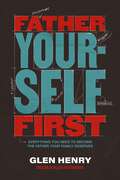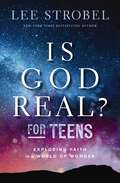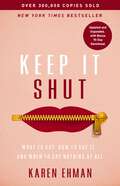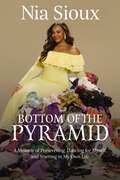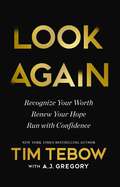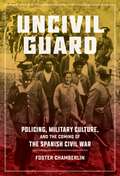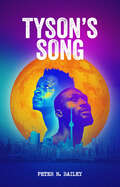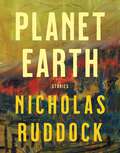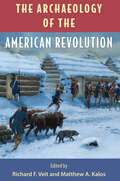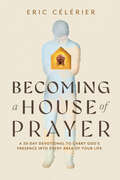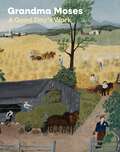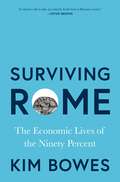- Table View
- List View
Father Yourself First: Everything You Need to Become the Father Your Family Deserves
by Glen HenryDiscover the secret to becoming the father your family deserves, whether you are a first-time dad or figuring it out as you go.Glen Henry never wanted to be a father. He grew up in a broken home and assumed that the role was worthless. Then he saw what a good father looked like and became passionate about not only being a good father himself but helping others see what fatherhood could be through his wildly popular YouTube channel, Beleaf in Fatherhood.Maybe you weren't given a handbook on fatherhood, but that doesn't mean you're unprepared. In fact, you have what it takes to grow into the kind of father your children need. In Father Yourself First, Glen offers hard-earned wisdom, honest storytelling, and six foundational principles that will help you:Father yourself to maintain a healthy inner voiceParent from a place of healing by addressing unresolved issues from your own pastConnect with your children by embracing childishness and adventureIdentify your children's unique gifts early on and help fine-tune their skills into productive habitsEstablish a community of fathers to exchange values and practices, and regularly see examples of healthy fatherhood Whether you're stepping into fatherhood for the first time or figuring it out as you go, Father Yourself First will meet you right where you are—and walk with you as you become the father your family deserves.
Is God Real? for Teens: Exploring Faith in a World of Wonder
by Lee StrobelDrawing on decades of research found in his Case for . . . series, as well as new interviews and insights, investigative journalist and former atheist Lee Strobel presents clear and compelling evidence to help seekers and believers answer life's ultimate question: Is God Real?Lee Strobel, weaves together the latest evidence from a range of brilliant scientific and philosophical minds to answer the most consequential question of all time. Is God Real? Teen Edition is tailored specifically for young minds. This engaging book unpacks evidence for God&’s existence with relatable stories, clear answers, and thought-provoking insights.From science and history to personal faith journeys, Strobel guides teens through doubts and skepticism to discover the truth about God. Perfect for parents and grandparents seeking to spark meaningful conversations, this book empowers teens to build a strong, evidence-based faith that stands firm in today&’s world. Equip your teen with the confidence to know: God is real, and He&’s closer than they think.
Keep It Shut: What to Say, How to Say It, and When to Say Nothing at All (Updated and Expanded, Including a Bonus 10-Day Devotional)
by Karen EhmanMORE THAN 300,000 COPIES SOLD!Gain practical insights into breaking habits of gossip, flattery, verbal retaliation, and people-pleasing in this encouraging and biblical resource on taming your tongue.Got words? Oh yeah, you do! The average person speaks over 2.5 million per year--not to mention the ones they type online. In this fully updated and expanded edition of Keep It Shut, Karen Ehman--a woman whose words have often landed her in a heap of trouble (you'll find out more about that in chapter one)--shares the how's (and how-not-to's) of dealing with the tongue's enormous power.Now with an all-important bonus chapter on how we talk to ourselves as well as a 10-day devotional on watching our words, including an explanation of a different biblical Greek or Hebrew word each day, Keep It Shut will teach you:The difference between gossip and properly processing with a trusted friend.How to wisely use our digital tongues as we talk online or on social media.How to pause before you pounce, attacking the problem but not the person.How to avoid saying something permanently painful just because you are temporarily ticked off.What the Bible teaches about making our speech laced with grace, as sweet as honey, and yet seasoned with saltUsing biblical examples as well as Karen's own personal (and sometimes painful!) stories, Keep It Shut will equip you to know what to say, how best to say it, and when you'd better just keep your lips zipped!
Wuthering Heights (Harper Muse Classics: Painted Editions)
by Emily BronteFeaturing beautiful cover art from artist Laci Fowler, this fine collector's edition of Emily Brontë's Wuthering Heights is a must-have for book lovers and literature fans. One of English literature's classic masterpieces—a gripping novel of love, propriety, and tragedy.In this classic gothic story, Catherine Earnshaw is forced to choose between passionate, tortured foundling Heathcliff and gentle, well-bred Edgar Linton. Catherine surrenders to the expectations of her class and sets off a domino effect with lasting consequences. As bitterness and vengeance at this betrayal are visited upon the next generation, Catherine and Heathcliff's innocent heirs must struggle to escape the legacy of the lovers' tortured past.Whether you're buying this as a gift or for yourself, this remarkable edition features: a beautiful high-end hardcover featuring Laci Fowler's distinctive hand-painted art, perfect for standing out on any discerning fiction lover's bookshelf; embossed cover art and gold foiling; decorative interior pages featuring pull quotes distributed throughout; a matching ribbon marker; and gold page edges.
Bottom of the Pyramid: A Memoir of Persevering, Dancing for Myself, and Starring in My Own Life
by Nia Sioux"Sioux&’s harrowing reality TV ordeal cuts deep, and her subsequent self-assurance is endearing and infectious. It adds up to an inspiring account of reclaiming artistic agency.&” - Publisher&’s WeeklyWhen you&’ve been told over and over that you belong at the bottom, how do you come out on top? Dance Moms star and triple threat Nia Sioux shows the way via her story of resilience, triumph, and defining success for herself.Young dancer Nia Sioux was only nine years old when she stepped into stardom as one of the original cast members of Lifetime&’s reality TV show Dance Moms. Nia learned new choreography week after week and competed against dancers from across the country as well as at her own studio. Perhaps her greatest obstacle was suffering through her dance teacher&’s ranking of the girls against each other in her infamous pyramid, where Nia spent the majority of her time on the bottom—all in front of an audience of millions.But there was much that viewers didn&’t see. How her experiences in the studio went far beyond what made it into the show. How she was ostracized for not fitting into an aesthetic that wasn&’t designed for girls like her. How her friendships and her mental health crumbled under the strain of the show. How she lost control of her story and her voice.But don&’t be fooled—this is a story about resilience. Nia is not looking for pity, sympathy, or validation as she reflects on her experiences. Instead, she is choosing to use her story as a celebration of triumph. Nia finally gets to tell her story in her own way and in her own words. In this captivating memoir, Nia reclaims both the spotlight and her narrative.In addition to going behind the scenes of the seven seasons of Dance Moms, she shows how she fought against the negative perceptions that dominated her tween and teen years and emerged as a confident young woman secure in her talents and her direction. Anyone who has ever felt misunderstood, overlooked, or stuck at the bottom of the pyramid will be inspired by Nia&’s story of overcoming. &“Despite barriers and constant naysayers, assumptions and criticisms, only you know who you are inside and out,&” Nia says. &“And you have the power to create your own narrative, your own level of success.&”
Look Again: Recognize Your Worth. Renew Your Hope. Run with Confidence.
by Tim TebowEvery one of us is infinitely valuable to God. What would it mean to live that way?New York Times bestselling author Tim Tebow shares a dynamic message on identity, meaning, and purpose. Highlighting his work with some of the world's most vulnerable populations, Tebow unlocks a powerful truth: Everything changes when we learn to see the image of God in every human; ourselves, our neighbors, and even our enemies. With powerful personal stories and profound spiritual principles, Tebow gives readers the tools and inspiration they need to impact their homes, neighborhoods, communities, and culture for good.In Look Again, Tebow inspires you tostand up to the lies and fight for the truth,see everything and everyone differently, including yourself, and joyfully rediscover the infinite worth of every person in the world, including people society rejects. &“God has done something incredible for you...Not because everything in your life is perfect, but because you know the One who holds your future. And when you know how deeply you&’re loved, you can step forward boldly, even when the odds are stacked against you.&”—Tim Tebow
Uncivil Guard: Policing, Military Culture, and the Coming of the Spanish Civil War (New Hispanisms: Cultural and Literary Studies)
by Foster ChamberlinIn Uncivil Guard: Policing, Military Culture, and the Coming of the Spanish Civil War, Foster Chamberlin evaluates the role of militarized police forces in the political violence of interwar Europe by tracing the evolution of one such group, Spain’s Civil Guard, culminating in the country’s turbulent Second Republic period of 1931–1936. As Chamberlin’s analysis shows, political violence provided the main justification for the military coup attempt that began the Spanish Civil War, and the Civil Guard was the most violent institution in the country at that time. Discovering how this police force, which was supposed to maintain order, became a principal contributor to the violence of the republic proves key to understanding the origins of the Civil War. By tracing the institution’s founding in the mid-nineteenth century, and moving through case studies of episodes of political violence involving the group, Chamberlin concludes that the Civil Guard had an organizational culture that made it prone to violent actions because of its cult of honor, its distance from the people it policed, and its almost entirely military training.
Earworm
by Mohammad YaghoubiHave you ever had a voice lodged in your memory that won’t go away? Clawing at your skin, bones, and nerves until it’s all you can think about? For Homa, an Iranian refugee living in Canada with her son Pendar, this is her daily torment. Haunted by the trauma of torture under the oppressive Islamic regime, Homa channels her pain into activism as an outspoken podcaster, fiercely condemning the human-rights violations in Iran. But her freedom is tested when she discovers that the father of Pendar’s new girlfriend is a devout Islamist and requests she wear a hijab in his presence. As the voices in her mind grow louder, Homa fears the nightmares from her past have followed her right to her doorstep.In Earworm, provocateur Mohammad Yaghoubi delivers a brilliant thriller that interrogates the fragile promises of political asylum and resonates not just with Iranian immigrants, but with all who have fled persecution in their homeland only to encounter their oppressors once again in their new country. Created in solidarity with the 2022 international Woman, Life, Freedom demonstrations that originated in Iran, this confrontational, clever, and suspenseful drama burrows deep under your skin and lingers long after its shocking conclusion.
Women United: Stories of Women’s Struggles for Equality in the Canadian Auto Workers Union
by Julie White Peggy NashBased on the firsthand stories of dozens of women leaders in the Canadian Auto Workers (CAW), Women United examines what workplaces were like for women, how they became involved in the union, and the challenges women faced, sometimes at great personal cost. From struggles for representation in their union to their fight for affirmative action and childcare, and work against gender-based violence and harassment, Peggy Nash and Julie White show how these feminist activists were joined in struggle not only by their union sisters, but also by their sisters from the broader women’s movement, who learned from them about the importance of women’s workplace rights. Nash and White document the decades-long struggles of generations of women activists in the CAW, who, despite their few numbers, managed to build a better, more inclusive union. A testament to the union’s motto that "fighting back makes a difference," Women United makes an important contribution to feminist, labour, and social history.
Tyson's Song
by Peter N. BaileyBest friends Bryan and Tyson are out for a night in Toronto before Bryan leaves for Vancouver in the morning. But when they miss the late-night bus with a six-pack in tow, everything the two men have bottled up about their friendship starts pouring out—like Bryan’s struggles as a husband and father or Tyson’s volatile outbursts since he got out of prison. As their moonlit vigil unfolds and an ominous police cruiser circles nearby, the ramifications of Bryan’s departure become heartbreakingly clear. Can they save their relationship—and maybe even their lives—before the next bus arrives?Peter N. Bailey’s powerful debut illuminates the complex dynamics of Black masculinity and brotherhood in a world that too often denies Black men love, compassion, and care. A catalyst for vital conversations about men’s mental health, Tyson’s Song is a tender portrait of two souls in limbo and a rallying cry for a new kind of conversation—one born of trust and the courage to lay bare our humanity.
Planet Earth: Stories
by Nicholas RuddockInternational award–winning stories of life and love in the midst of planetary decline In Planet Earth, Nicholas Ruddock moves nimbly through a range of styles—from conventional to flash-fiction to his unique mastery of the long sentence—in stories exploring themes of love and passion, all with an awareness of our species-specific carelessness burning up the world. This collection showcases a gifted writer at the top of his game, each story fresh and unexpected: the time Mario Vargas Llosa sucker-punched Gabriel García Márquez at a theatre in Mexico City inspires a young Marxist couple’s violent act of revenge in Toronto years later; an anxious young man finds solace in the employ of Prince, the musician; we get a haunting glimpse of Toronto’s polio epidemic at its peak in 1953; a young Canadian student bears witness to the Algerian protests and police violence in 1961 Paris; a pair of naive young women find themselves involved with a mysterious circus troupe in Nice. These provocative but contemplative stories are paradoxically positive and quick-witted, with a humorous fondness for humans and all our failings.
The Archaeology of the American Revolution
by Richard F. Veit Matthew A. KalosNew interpretations of the Revolutionary War era in a wide-ranging collection of cutting-edge archaeology and interdisciplinary insights Although the American Revolutionary War has been extensively studied by archaeologists, this volume is the first to take a holistic approach to this storied conflict, incorporating perspectives of the field and related disciplines. The Archaeology of the American Revolution draws on the expertise of a variety of scholars who move beyond the traditional focus on military camps, battlefields, and famous leaders to provide fresh insights into the war’s broader impacts.This volume connects historical narratives with material culture, explores how cutting-edge archaeological methods like LiDAR and drone technology have illuminated previously undiscovered sites, and examines how material remnants and memorials shape the ways the war is remembered. The diversity of approaches in these chapters, including archaeology, public history, and forensic anthropology, offers brand-new perspectives on often-studied events. Topics range from the earliest days of the war in New England to the fighting in the mid-Atlantic and finally the partisan conflicts in the southern campaign.The research gathered in this volume is essential for understanding the multifaceted nature of the American Revolution and the many ways this era can be studied. In bringing together interdisciplinary contributions, this collection enhances, questions, and even contradicts accepted beliefs about the Revolution, offering valuable new interpretations of this critical period in American history.Contributors: Steven D. Smith | Thomas Crist | Wade P. Catts | Saine C. Hernandez-Burgos | Sean McHugh | Garry Wheeler Stone | Kim Arbogast McBride | W. Stephen McBride | Stephen D. Nagiewicz | Joel Dukes | Adam Heinrich | Jennifer Janofsky | Andrew M. Outten | William A. Griswold | Evan Mydlowski | Michael C. Brown | Richard Veit | Matthew A Kalos | Robert Selig | Douglas D. Scott | Joel R. Bohy | M. Denise Dennis | Steven Santucci | Jaclyn Fischer | Hillary A. DelPrete
An Eye for an I: Growing up with Blindness, Bigotry, and Family Mental Illness
by James Francisco BonillaThe personal story of a blind Puerto Rican boy in New York who transcends a harrowing childhood to become a lifelong advocate for social justice &“Jovencito, it&’s going to be lonely being different and yet strong in this world,&” James Francisco Bonilla&’s grandmother told him when he was ten. He had come home after defending himself against a bully who had threatened him with violence, making it clear that he didn&’t care that James was blind. But despite the isolation James felt in childhood, he would come to commit his life to leveraging his differences and strengths toward a collective fight for justice. James&’s memoir, An Eye for an I, is an inspiring account of how he found a path through his own suffering to make a difference for others. Born with congenital cataracts, James had limited vision in his right eye and none in his left. At age nine, after a classmate hurled a horseshoe at his face in a racially motivated assault, James&’s right eye was injured and he became legally blind. At home, too, he feared physical violence, experiencing the unpredictable outbursts of a single mother suffering from severe mental illness. Throughout his youth as a Puerto Rican New Yorker, James was continually failed by educational systems that exposed him to one abuse after another. Searching for relief and inspiration, he discovered an unexpected solace in the natural world, spiritual encounters with Mother Earth that led him toward both personal healing and advocacy. At nineteen, a breakthrough in medical technology restored the sight in his right eye, and James recognized his unique perspective on the struggles of the disabled and marginalized in American life—and his intense will to make a difference. He seeks to understand generational trauma, and in documenting his growth—physically, mentally, and spiritually—his memoir exemplifies the introspection necessary to participate in truly equitable and effective movement building. An Eye for an I presents both James and his aggressors with refreshing nuance and humility, inviting readers to empathize, be inspired, and consider their own potential to be of service in a broken, yet beautiful, world. Retail e-book files for this title are screen-reader friendly with images accompanied by short alt text and/or extended descriptions.
Indigenous Inhumanities: California Indian Studies after the Apocalypse (Indigenous Americas)
by Mark Minch-de LeonReclaiming power and prophecy through California Indian intellectual resurgence and anticolonial resistance Mark Minch-de Leon explores the anticolonial dimensions of California Indian intellectual and cultural resurgence in the aftermath of apocalypse in this compelling reexamination of Indigenous art, literature, and theory. Centering on a reinterpretation of the Ghost Dance, a ceremony first practiced in the nineteenth century, as a collective demonstration of prophecy and resilience, Indigenous Inhumanities envisions an expanded poetics of resistance through a reconfigured relationship to death and the dead. By dismantling the colonial frameworks of inclusion, recognition, and representation that reinforce settler-state power, Minch-de Leon shows how storytelling can be reclaimed as both research and as a tool for decolonization. Taking up critical issues that the state has used to discipline California Indian relations to ancestors, such as the politics of human remains repatriation and the discourse around California Indian genocide, Minch-de Leon centers Indigenous knowledge and social systems while challenging legal and political definitions of violence, power, and the human. Rich case studies showcase the evocative art of Frank Day, the poetry of Tommy Pico, and the writings of Deborah Miranda, highlighting how these creators advance Indigenous theory and disrupt settler categories. By refusing reconciliation and embracing Indigenous frameworks of radical relationality and the &“inhuman&” (what lies outside of human control), Minch-de Leon presents a bold vision of Indigenous antihumanist survival and resurgence. Indigenous Inhumanities illuminates the path toward decolonial futures by following the radical turn the ancestors made toward the powers of the dead to bring an end to the colonial world. Retail e-book files for this title are screen-reader friendly with images accompanied by short alt text and/or extended descriptions.
Spectropolis: The Enchantment of Capital in Singapore
by Joshua ComaroffHow economic transformation and the spirit world collide in hypermodern Singapore In Singapore, the financial center of Southeast Asia, hyperurbanization and commercial development exist alongside enduring belief in the economic power of ghosts: in their ability to control the flows of money and value and to determine the outcome of investments and wagers. Spectropolis explores the unlikely collusion of these two systems, demonstrating both the productive role of popular beliefs in the modern world and the surprising correlations between &“late&” capitalism and the workings of the spirit realm. Detailing the logic and practices of Singapore&’s ghost economy—from performing exorcisms on real estate development sites to offering money and commodities to the dead as a hedge against precarious real-world transactions—Joshua Comaroff shows how speculative finance, largely governed by chance and volatility, is understood via its inherently spectral qualities. Through the influence of Chinese Buddhist-Taoist thought, the movement of capital is placed under the sway of cosmology and geomancy, resulting in a built environment that is both technologically advanced and quite literally enchanted. Based on detailed case studies and years of extensive fieldwork, Spectropolis argues for the power of popular belief systems to theorize contemporary socioeconomic conditions and to give form to collective affect as well as shared aspirations and anxieties. As Comaroff demonstrates, the uniquely all-consuming nature of Singapore&’s tightly compressed urban economy is such that it may subsume even that which lies beyond the threshold of life itself. Retail e-book files for this title are screen-reader friendly with images accompanied by short alt text and/or extended descriptions.
First Light: Kanaka 'Oiwi Resistance to Settler Science at Mauna a Wakea
by Iokepa Casumbal-SalazarUnderstanding the Hawai‘i Island summit of Mauna a Wākea as a place of ancestral connection, cultural resurgence, and political resistance for Native Hawaiians First Light is a site-specific study of Native Hawaiian resistance to the construction of the Thirty Meter Telescope (TMT) on the summit of Mauna a Wākea, the sacred mountain on the island of Hawai‘i. Drawing on personal interviews, oral histories, archival research, participant observation, and popular, legal, scientific, and Indigenous discourses, Iokepa Casumbal-Salazar explores both the campaign to build the observatory and the movement against it. He asks how astronomers have become stewards of Mauna a Wākea while Kānaka ‘Ōiwi (Aboriginal Hawaiians), in protest, are recast as obstructing progress and clinging to ancient superstitions.Contextualizing contemporary resistance to telescope expansion within the past 132 years of struggle against U.S. empire in Hawai‘i, Casumbal-Salazar argues the Kanaka-led efforts to protect their ancestral lands did not begin with the TMT and only become legible when understood in the broader history of resistance to U.S. settler hegemony as told through the voices and actions of kiaʻi ʻāina (land defenders). First Light explores how settler science, capital, and law have been mobilized in ways that rationalize industrial development projects like the TMT and promote a vision of “coexistence” that enables the dehumanization of Kānaka ‘Ōiwi and their alienation from ʻāina.Challenging the assumptions and aggressions of neoliberal environmental policy, settler multiculturalism, and U.S. military occupation, First Light reinforces calls for a moratorium on new telescope development and a literacy in Kanaka ‘Ōiwi movements for life, land, and ea (independence, sovereignty).Retail e-book files for this title are screen-reader friendly with images accompanied by short alt text and/or extended descriptions.
The Youngest Yugoslavs: An Oral History of Post-Socialist Memory
by Jovana BabovićReflecting on the final decades of socialism, eight individuals born in former Yugoslavia between 1971 and 1991 recount their memories of childhood and early adulthood, and how that time period has made a lasting impact on their lives.The Youngest Yugoslavs is an oral history collection that gives its readers in-depth, varied perspectives on why Yugoslavia continues to resonate among its former citizens more than 30 years since the state collapsed amid war, genocide, and dislocation. Their interviews with author Jovana Babović' showcase how these individuals remember their childhoods during the final decades of socialism and how they conceptualize the lasting impact Yugoslavia has had on their lives.The Youngest Yugoslavs offers insight on how this generation of Yugoslav individuals have reconciled the loss of their homeland and how they have continued to find meaning in the Yugoslav past as both a lived experience and as a set of ideals.
Becoming a House of Prayer: A 30-Day Devotional to Carry God's Presence into Every Area of Your Life
by Eric CélérierWhat if prayer was less about guilt and more about joy? Less about confusion and more about mystery? Less about a way to talk to God and more about the way God lives in you?Prayer isn’t just a moment in your day—it’s a calling that shapes who you are. In Becoming a House of Prayer, Pastor Eric Célérier shows you how to follow the Lord’s Prayer as a divine blueprint for intimacy with God. If you are confused about how to pray, feel stuck in your prayer life, or simply long for more intentional spiritual formation, this book guides you to:Discover the treasures hidden in each line of the Lord’s Prayer.Integrate prayer into your daily rhythms using practical prayer exercises. Find soul-deep peace as you realize the power of Jesus in you.Elevate prayer from more than a part of your life to the shape of your life. Including reflection questions for individuals or groups, Becoming a House of Prayer invites you into the joyful awareness that Jesus stands at the door of your heart, ready to fill every room in your soul with His life-giving presence.
Una casa de oración: Un devocional de 30 días para llevar la presencia de Dios a cada área de tu vida (Becoming a House of Prayer) (Spanish)
by Eric Célérier¿Y si la oración fuera menos sobre la culpa y más sobre el gozo? ¿Menos sobre la confusión y más sobre el misterio? ¿Menos sobre una manera de hablar con Dios y más sobre la manera en que Dios vive en ti?La oración no es solo un momento en tu día, es un llamado que moldea quién eres. En Una Casa de Oración, el pastor Éric Célérier muestra cómo seguir la oración del Padre Nuestro como un modelo divino para tener intimidad con Dios. Si tienes dudas sobre cómo orar, sientes estancamiento en tu vida de oración o simplemente anhelas más formación espiritual intencional, este libro te guiará a:Descubrir los tesoros ocultos en cada línea del Padre Nuestro.Incorporar la oración en tu vida diaria usando ejercicios prácticos de oración. Encontrar paz profunda para tu alma mientras descubres el poder de Jesús en ti.Mejorar tu oración de ser más que una parte de tu vida a ser tu forma de vida.Al incluir preguntas para reflexionar individualmente o en grupo, Una Casa de Oraciónte invita a percibir gozosamente que Jesús está a la puerta de tu corazón, listo para llenar cada espacio en tu alma con Su presencia que da vida.What if prayer was less about guilt and more about joy? Less about confusion and more about mystery? Less about a way to talk to God and more about the way God lives in you?Prayer isn’t just a moment in your day—it’s a calling that shapes who you are. In Becoming a House of Prayer, Pastor Éric Célérier shows you how to follow the Lord’s Prayer as a divine blueprint for intimacy with God. If you are confused about how to pray, feel stuck in your prayer life, or simply long for more intentional spiritual formation, this book guides you to:Discover the treasures hidden in each line of the Lord’s Prayer.Integrate prayer into your daily rhythms using practical prayer exercises. Find soul-deep peace as you realize the power of Jesus in you.Elevate prayer from more than a part of your life to the shape of your life.Including reflection questions for individuals or groups, Becoming a House of Prayer invites you into the joyful awareness that Jesus stands at the door of your heart, ready to fill every room in your soul with His life-giving presence.
Grandma Moses: A Good Day's Work
by Leslie Umberger Randall R. GriffeyA major reexamination of the life, art, and legacy of a self-taught American masterGrandma Moses: A Good Day&’s Work repositions Anna Mary Robertson &“Grandma&” Moses (1860–1961) as a multidimensional force in American art, whose beloved recollections of rural life earned her a distinctive place in the cultural imagination of the postwar era. Moses was eighty years old when Otto Kallir, a New York art dealer and recent émigré from Nazi-held Austria, introduced her to the world. &“Grandma Moses,&” as the press dubbed her, quickly became a polarizing figure, beloved by the public yet dismissed by the art world for her story-time scenes and lack of formal training.Drawing on Moses&’s reflection on her own life as &“a good day&’s work,&” the book charts Moses&’s creative development from her earliest artistic efforts to the emergence of her signature style, revealing a multidimensional artist who fused direct observation of nature, labor, and personal memories to tell idiosyncratic yet compelling stories. It positions Moses as a central figure in the history of twentieth-century American art, a painter whose life and work bore witness to the Civil War, two world wars, and the civil rights era.Beautifully illustrated, Grandma Moses: A Good Day&’s Work captures the indomitable spirit Moses brought to her artmaking, conveying a candor and authority that still resonate today with the quest for a homespun American visual tradition.Published in association with the Smithsonian American Art Museum, Washington, DCExhibition ScheduleSmithsonian American Art Museum, Washington, DCOctober 24, 2025–July 12, 2026
Surviving Rome: The Economic Lives of the Ninety Percent
by Kim BowesA radical revision—and worker&’s-eye view—of everything we thought we knew about the ancient Roman economyThe story of ancient Rome is predominantly one of great men with great fortunes. Surviving Rome unearths another history, one of ordinary Romans, who worked with their hands and survived through a combination of grit and grinding labor.Focusing on the working majority, Kim Bowes tells the stories of people like the tenant farmer Epimachus, Faustilla the moneylender, and the pimp Philokles. She reveals how the economic changes of the period created a set of bitter challenges and opportunistic hustles for everyone from farmers and craftspeople to day laborers and slaves. She finds working people producing a consumer revolution, making and buying all manner of goods from fine pottery to children&’s toys. Many of the poorest working people probably pieced together a living from multiple sources of income, including wages. And she suggests that Romans&’ most daunting challenge was the struggle to save. Like many modern people, saving enough to buy land or start a business was a slow, precarious slog. Bowes shows how these economies of survival were shared by a wide swath of the populace, blurring the lines between genders, ages, and legal status.Drawing on new archaeological and textual evidence, Surviving Rome presents a radical new perspective on the economy of ancient Rome while speaking to the challenges of today&’s laborers and gig workers surviving in an unforgiving global world.
Shared Prosperity in a Fractured World: A New Economics for the Middle Class, the Global Poor, and Our Climate
by Dani RodrikNew, practical approaches to confronting today&’s most daunting global issuesFighting climate change, saving democracy, and eradicating poverty are urgent global challenges, yet the world&’s leaders continue to pursue outdated policies that focus on one while worsening the tradeoffs between each of them. Shared Prosperity in a Fractured World shows how the nations of the world can achieve all three objectives.Dani Rodrik provides a bold new vision of globalization, one in which we accelerate the green transition to achieve a sustainable planet, shore up the middle class to restore democracy&’s foundations, and hasten economic revitalization in the developing world to put an end to poverty. The rising tide of authoritarianism has demonstrated our inability to alleviate economic anxieties. Economic nationalism has raised the specter of increased protectionism and deteriorating prospects for economic growth. And automation and other new technologies have undercut the advantages of low-cost, unskilled labor in manufacturing and export-oriented industrialization. Rodrik reveals how we can restore prosperity through new forms of collaborative public-private action—to promote renewables and green industries, middle-class jobs, and enhanced productivity in labor-absorbing services—even in the absence of global cooperation. He explains why this new kind of globalization must also recognize the legitimate desire of governments to pursue their economic, social, and security interests autonomously.Turning conventional economic wisdom on its head, Shared Prosperity in a Fractured World builds on practices that work while radically transforming those that don&’t, presenting a grounded, clear-eyed approach to tackling the problems that affect us all, at home and around the world.
Two Paths to Prosperity: Culture and Institutions in Europe and China, 1000–2000
by Joel Mokyr Avner Greif Guido TabelliniHow the social organization of Europe and China shaped their divergent economic and political trajectories over the past millenniumIn the eleventh century, when Europe was still backward and poor, China was a rich and sophisticated civilization. Yet Europe became the birthplace of democracy and the Industrial Revolution, driving the Great Enrichment, while China stagnated until the end of the twentieth century and was always ruled by autocracies. Two Paths to Prosperity traces the emergence of two very different social organizations in premodern China and Europe—the clan and the corporation—showing how they were key factors in the economic and political divergence of these two great civilizations.In this landmark book, three leading economists offer a bold new account of why Europe and China evolved along such different trajectories. In the early Middle Ages, public goods like risk sharing, religious worship, education, and conflict resolution were provided by nonstate organizations in both societies. China increasingly relied on kin-based cooperation within clans, while weaker kinship ties in Europe gave rise to corporations such as guilds, universities, and self-governing towns. Despite performing similar functions, clans and corporations were built on very different principles—with lasting consequences until today.Providing a novel answer to a fundamental question in economic and political history, Two Paths to Prosperity shows how extended kinship in Chinese society facilitated the consolidation of autocracy and hindered innovation and economic development, and how corporations in Europe influenced emerging state institutions and set the stage for the Industrial Revolution.
On Pedantry: A Cultural History of the Know-it-All
by Arnoud S. VisserA lively and entertaining cultural history of a supremely annoying intellectual viceIntellectuals have long provoked scorn and irritation, even downright aggression. Many learned individuals have cast such hostility as a badge of honor, a sign of envy, or a form of resistance to inconvenient truths. On Pedantry offers an altogether different perspective, revealing how the excessive use of learning has been a vice in Western culture since the days of Socrates.Taking readers from the academies of ancient Greece to today&’s culture wars, Arnoud Visser explains why pretentious and punctilious learning has always annoyed us, painting vibrant portraits of some of the most intensely irritating intellectuals ever known, from devious sophists and bossy savantes to hypercritical theologians, dry-as-dust antiquarians, and know-it-all professors. He shows how criticisms of pedantry have typically been more about conduct than ideas, and he demonstrates how pedantry served as a weapon in the perennial struggle over ideas, social status, political authority, and belief. Shifting attention away from the self-proclaimed virtues of the learned to their less-than-flattering vice, Visser makes a bold and provocative contribution to the history of Western thought.Drawing on a wealth of sources ranging from satire and comedy to essays, sermons, and film, On Pedantry sheds critical light on why anti-intellectual views have gained renewed prominence today and serves as essential reading in an age of rising populism across the globe.
How to Change a Memory: One Neuroscientist’s Quest to Alter the Past
by Professor Steve RamirezA disarmingly personal account of the new science of memory manipulation by one of today&’s leading pioneers in the fieldAs a graduate student at MIT, Steve Ramirez successfully created false memories in the lab. Now, as a neuroscientist working at the frontiers of brain science, he foresees a future where we can replace our negative memories with positive ones. In How to Change a Memory, Ramirez draws on his own memories—of friendship, family, loss, and recovery—to reveal how memory can be turned on and off like a switch, edited, and even constructed from nothing.A future in which we can change our memories of the past may seem improbable, but in fact, the everyday act of remembering is one of transformation. Intentionally editing memory to improve our lives takes advantage of the brain&’s natural capacity for change.In How to Change a Memory, Ramirez explores how scientists discovered that memories are fluid—they change over time, can be erased, reactivated, and even falsely implanted in the lab. Reflecting on his own path as a scientist, he examines how memory manipulation shapes our imagination and sense of self. If we can erase a deeply traumatic memory, would it change who we are? And what would that change mean anyway? Throughout, Ramirez carefully considers the ethics of artificially controlling memory, exploring how we might use this tool responsibly—for both personal healing and the greater good.A masterful blend of memoir and cutting-edge science, How to Change a Memory explores how neuroscience has reached a critical juncture, where scientists can see the potential of memory manipulation to help people suffering from the debilitating effects of PTSD, anxiety, Alzheimer&’s, addiction, and a host of other neurological and behavioral disorders.
